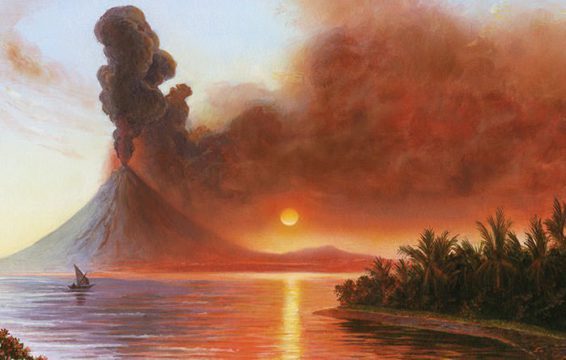The Tambora volcano located on the northern shore of the island of Sumbawa, 200 miles east of Bali, is clearly “off the beaten track” for tourist visitors to Indonesia and, as such, is granted little credit for its significant influence on the course of global history.
The greatest volcanic eruption of explosive intensity during the Holocene Era took place on 05 April 1815. The explosion registered a massive 7.0 on the VEI scale, emitting a volcanic column carrying 166 cubic kilometers of ejecta 44 kilometers into the atmosphere.
The accompanying explosion was heard as far as 1,200 miles away on the island of Sumatra. Despite its remote location, some 70,000 deaths are linked to Tambora’s eruption and its aftermath.
The explosion of Tambora is blamed for the extinction of a language spoken by people living on the mountain’s slopes and for providing the starting point for resulting climate change that formed the impetus for a mass migration that changed history’s course. The floating clouds of volcanic dust made the following year of 1816 “the year without a summer,” causing substantial temperature drops, unseasonal snowfall, and crops failures across Asia, Europe, and North America. The resulting climatic calamity, including the legendary Irish potato famine, sent millions fleeing to America, forever changing the history of the United States.
Recent archaeological excavation on Mount Tambora’s slopes uncovered the dwelling of a family that scientists believe died in the explosion. Quoted in Kompas.com, I Putu Yuda Haribuana, a researcher from the Bali Archaeological Center (Balai Arkeologi Bali), said, “the assumption is that these people had no opportunity to save themselves when Mount Tambora exploded.”
Other evidence discovered at the archaeological site are building components showing the dwelling was likely part of a populated settlement. Haribuana said evidence uncovered by his team shows those living in the house were part of a kingdom, a viewpoint supported by remnants of a harbor and fortress found nearby.
The archaeologists have also found the tools and ornaments of daily life that include ceramic bottles, cups, Dutch coins, spearheads, pendants, necklaces, rings, and other jewelry. Such items also prove that the early resident of Tambora enjoyed commercial contact with the larger world.
The slopes of Tambora have been resettled since 1907 by farmers who cultivate coffee in an area covering 80,000 hectares.
The Balinese archaeologist admits only a small corner of Tambora has been surveyed from a total land area covering a massive 1,500 square kilometers. He believes there is still much to be explored, excavated, and learned from the slopes of the historical volcano.
